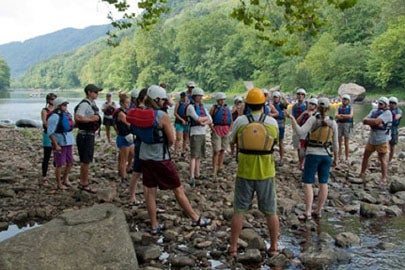|
May 6, 2014
Stanford researchers identify strategies for 'remaking' Appalachia's polluted waterways
Visible results of watershed restoration efforts inspire citizen action in one of the country's most environmentally damaged regions, according to Stanford research that points the way to more effective volunteer recruitment and motivation. By Rob Jordan

During a rafting trip down the New River in West Virginia, local community leaders learn about the importance of the projects of local watershed groups in their area. (Photo: Courtesy Heather Lukacs)
For many Americans, there is a single word that elicits images of both enduring poverty and environmental degradation: Appalachia.
New Stanford research published in the journal Society and Natural Resources paints a starkly different image of the mountainous region by focusing on an emerging movement of citizen volunteers working to clean up watersheds polluted by abandoned coal mines and sewage-clogged streams.
The study, which was co-authored by Heather Lukacs, a graduate student in Stanford's Emmett Interdisciplinary Program in Environment and Resources, and Nicole Ardoin, an assistant professor of education and center fellow at the Stanford Woods Institute for the Environment, finds that people share a common motivation to improve highly polluted places. The researchers also found that people were further motivated to participate in cleanup projects if they saw how other volunteers' efforts had restored previously polluted areas.
The researchers' findings about how these "remade places" encourage other projects could help organizations elsewhere recruit and motivate volunteers more effectively.
"Our research highlights the positive feedback loop between watershed group restoration efforts and volunteer participation," said Lukacs, the study's lead author. "When restoration projects and their results are visible, people are motivated to become involved in community action. Seeing others working to clean up their stream and community motivates volunteers to improve their place."
Throughout Appalachia, a lack of resources, infrastructure and government oversight has led to toxic waste sites and household sewage being discharged directly into waterways. More than 3 million people in the region live within one mile of an abandoned mine designated by the U.S. Department of the Interior as a "threat to health, safety and general welfare." All 13 of the watershed cleanup groups that Lukacs and Ardoin studied operated in areas with rivers and streams deemed "impaired" by the U.S. Environmental Protection Agency.
In recent years, some local residents have banded together to restore fish to streams that had, for generations, been too dirty to support them. They have also raised funds, supervised mine cleanups, tested water quality and advocated for basic wastewater services, among other projects.
In response to open-ended survey questions, volunteers expressed motivation to further enhance once-polluted places that already showed improvements through the efforts of other people. Among the respondents who expressed a new desire to pitch in: a fisherman who was inspired by the return of fish to a once heavily polluted creek, a retiree who was moved by his grandchildren's work to clean up a waterway and a teacher who saw tourism potential after volunteers removed debris from open trash dumps.
Volunteers also expressed motivation to be part of an inspiring social experience that "remakes" a place with more personal meaning. Of the more than 200 volunteers surveyed, 66 percent reported attending events such as stream cleanups, tree plantings or group meetings that provided social interaction. These social spaces provide an opportunity to be around people with shared values, to feel appreciated and to encourage community engagement among the young.
"Although the visible outcomes of watershed group efforts may seem small relative to the massive impacts of coal and gas development in the region, remade places served as powerful symbols of local collective action to address pollution caused by others," the study's authors wrote.
Watershed groups elsewhere could learn from Appalachia's example, the study suggests. Volunteer recruitment and motivation efforts could benefit from opportunities to "observe and showcase the results of place remaking" through demonstrations of restoration project results, interaction with other volunteers and natural systems education opportunities.
For more Stanford experts on the environment and other topics, visit Stanford Experts.
-30-
|